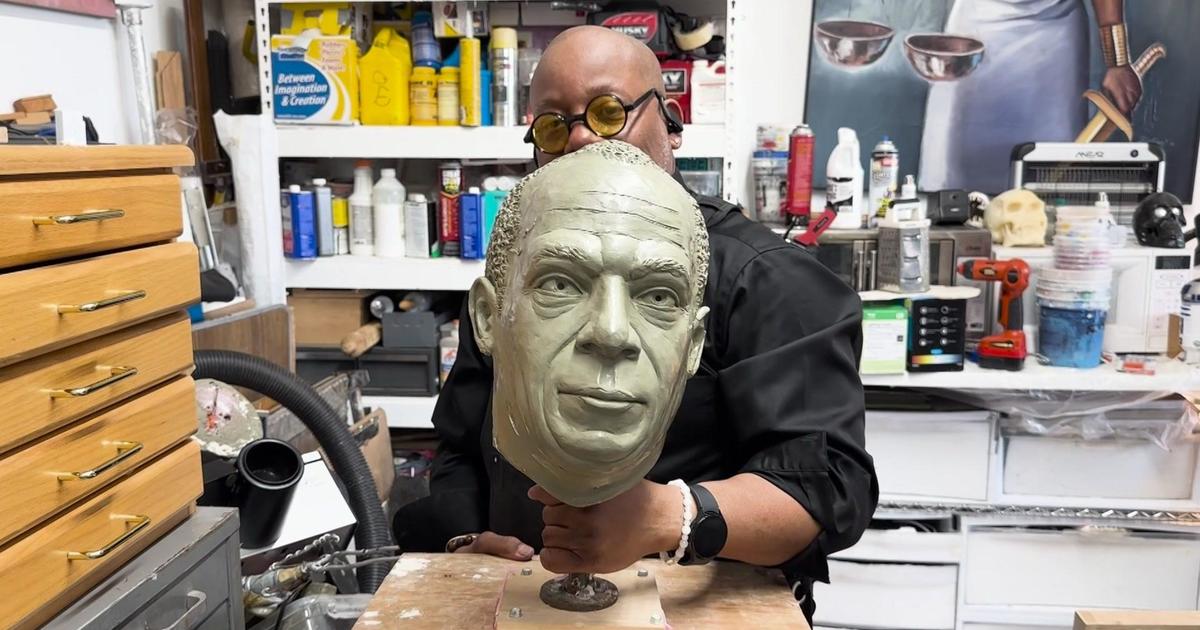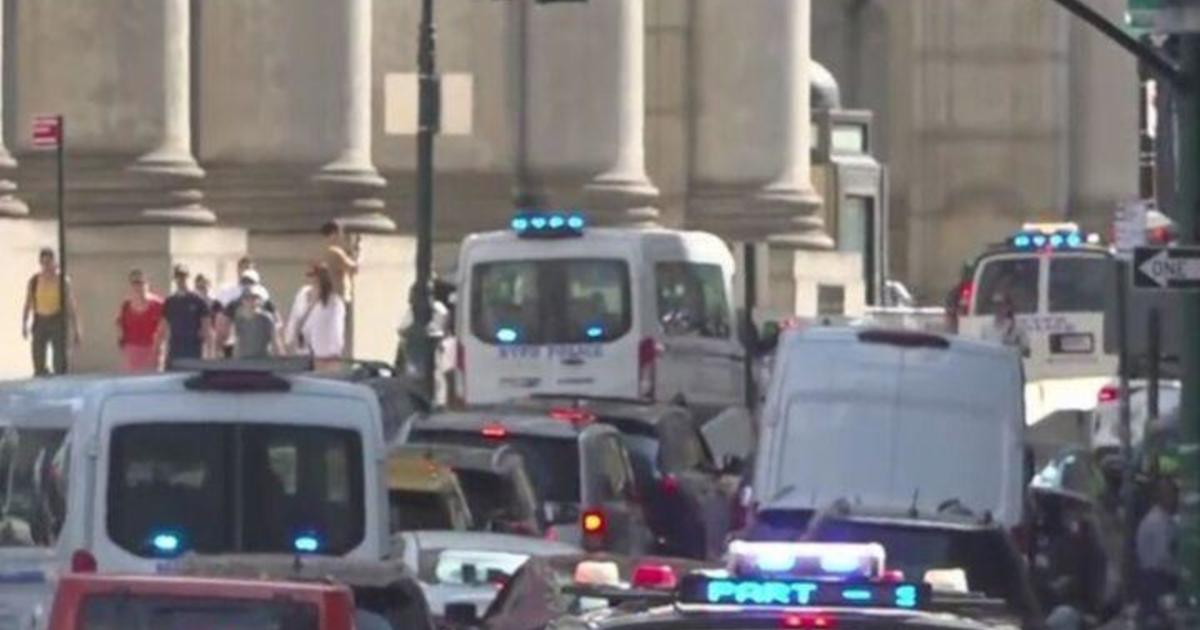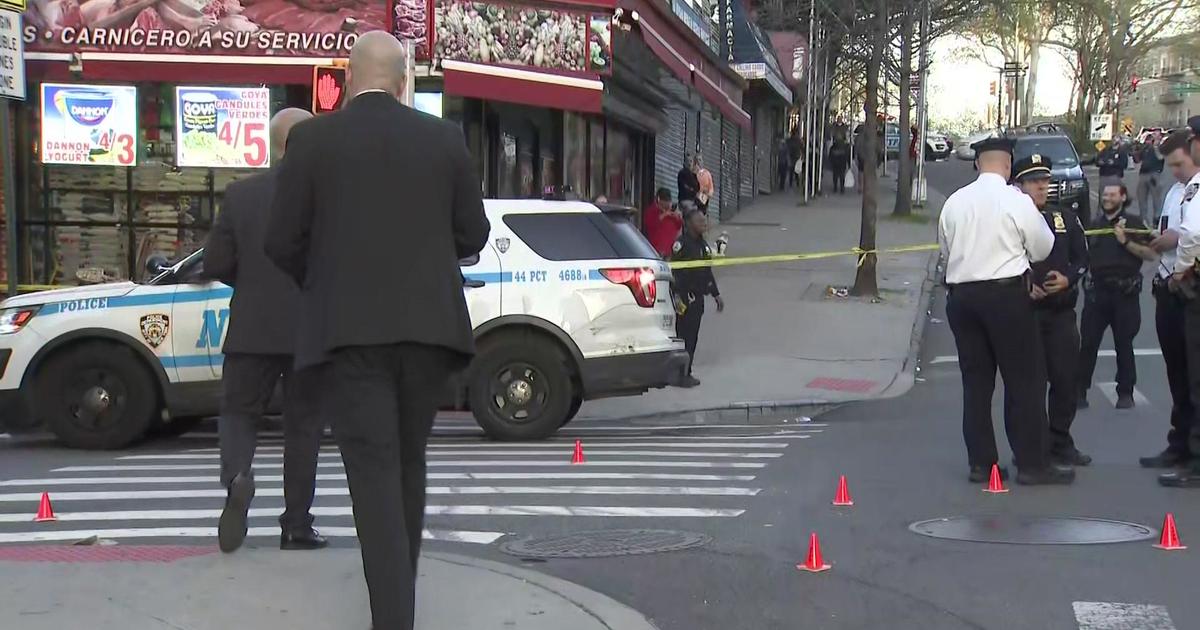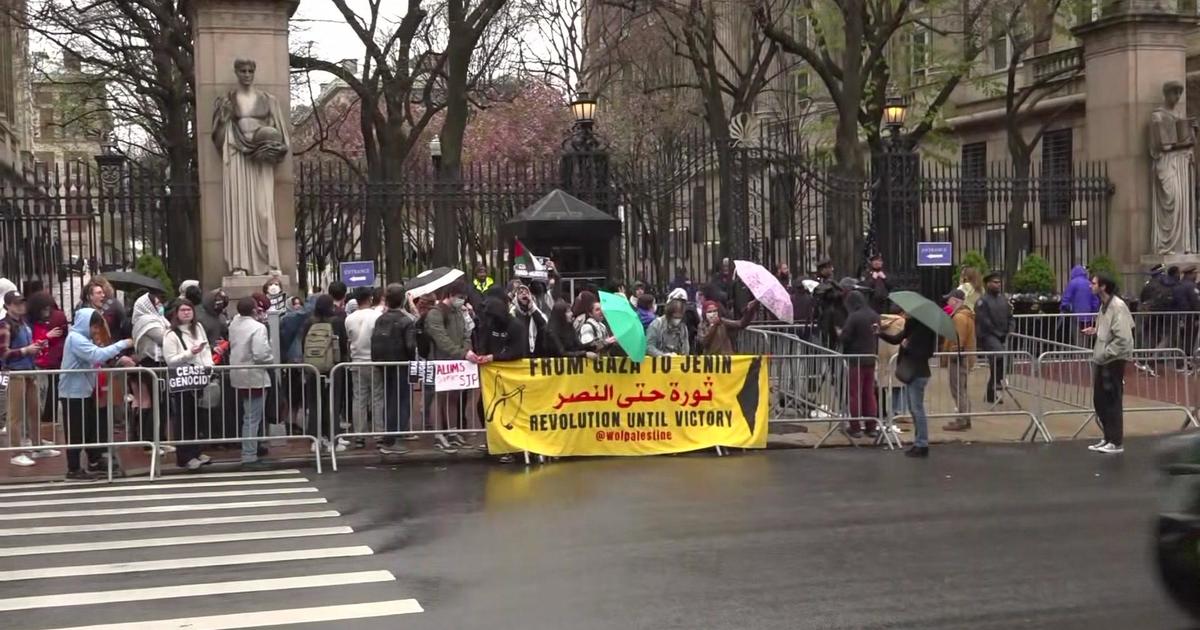Hurricane Irma Barrels Toward Florida, Taking Aim At St. Petersburg
MIAMI (CBSNewYork/AP) — Hurricane Irma's leading edge brought hurricane-force winds to the Florida Keys late Saturday, bending palm trees and spitting rain as the storm swirled north with 120 mph (190 kph) winds on a projected new track that could expose St. Petersburg -- not Miami or even Tampa -- to a direct hit.
St. Petersburg, like Tampa, has not taken a head-on blow from a major hurricane in nearly a century.
MORE: Latest Hurricane Updates From CBS Miami
By late Saturday night, people on the mainland were already feeling the effects, as the winds and rain picked up and some areas started to see flooding.
The storm was spinning up funnel clouds and threatening tornadoes.
The National Hurricane Center's latest tweak to Irma's forecasted track has the storm hugging the Florida's west coast off Fort Myers, but possibly not making landfall there before moving back to the Gulf of Mexico. By moving the likely track a few crucial miles west, the storm would be able to regain strength over water before its deadliest winds hit St. Petersburg and Clearwater, rather than the more populated Tampa.
After that, the storm is now expected to skirt the coast again a bit north of Horseshoe Beach, then finally go inland around Fish Creek, northwest of Ocala, with a hurricane-force wind field well over 100 miles wide.
Irma's forward motion slowed to 6 mph (10 kph) as the storm stuttered off the coast of Cuba. Forecasters say it could still increase in strength, but their forecast didn't show it.
An estimated 70,000 Floridians huddled in shelters as Irma closed in on the Keys, where the storm's center was expected to swirl over land Sunday morning.
"This is your last chance to make a good decision," Gov. Rick Scott warned residents in Florida's evacuation zones, which encompassed a staggering 6.4 million people, or more than 1 in 4 people in the state.
Earlier Saturday, the governor issued urgent warnings to a third of his state's residents to get out ahead of the massive hurricane.
"You need to leave -- not tonight, not in an hour, right now," he said to residents living in evacuation zones during an afternoon press conference. "This is the most catastrophic storm the state has ever seen."
Earlier in the day, Irma executed a westward swing toward Florida's Gulf coast that appeared to spare the Miami metropolitan area of the catastrophic direct hit that forecasters had been warning of for days.
Still, Miami was not out of danger. Because the storm's damaging winds stretch 350 to 400 miles wide, forecasters said the metro area of 6 million people could still get life-threatening gusts and a storm surge of 4 to 6 feet.
Irma -- at one time the most powerful hurricane ever recorded in the open Atlantic -- left more than 20 people dead across the Caribbean as it steamed toward the U.S.
It was chugging toward Florida as a Category 3, with winds down considerably from their peak of 185 mph (300 kph) earlier in the week.
Meteorologists predicted Irma would plow into the Tampa Bay area by Monday morning, delivering the area its first major hurricane since 1921, when its population was about 10,000, National Hurricane Center spokesman Dennis Feltgen said. Now the area has around 3 million people.
The new course threatens everything from Tampa Bay's bustling twin cities to Naples' mansion- and yacht-lined canals, Sun City Center's retirement homes, and Sanibel Island's shell-filled beaches.
The course change from Florida's east coast caught many off guard and triggered a major round of evacuations. Many west coast businesses had yet to put plywood or hurricane shutters on their windows, and some locals grumbled about the forecast.
"For five days, we were told it was going to be on the east coast, and then 24 hours before it hits, we're now told it's coming up the west coast," said Jeff Beerbohm, a 52-year-old entrepreneur in St. Petersburg. "As usual, the weatherman, I don't know why they're paid."
Nearly the entire Florida coastline remained under hurricane watches and warnings, and leery residents watched a projected track that could still shift to spare, or savage, parts of the state.
Forecasters warned of storm surge as high as 15 feet.
"This is going to sneak up on people," said Jamie Rhome, head of the hurricane center's storm surge unit.
With the new forecast, Pinellas County, home to St. Petersburg, ordered 260,000 people to leave, while Georgia scaled back evacuation orders for some resident's of the state's Atlantic shore. Motorists heading inland from the Tampa area were allowed to drive on the shoulder.
CBS2's Jessica Layton was in Miramar, just north of Miami, where she met several people riding out the storm at a hotel Saturday.
"We're afraid about the storm and we don't want to be hurt," resident Carolina Carrasco said.
Carrasco's house is only 10 minutes from the hotel, but with her 7-month-old in her arms and 4-year-old by her side, she felt they were better off there.
"Go to the stairwells and look for safety," she said, adding that what scared her most was "that something happens and I can't help my babies."
Layton met tired people from all over Florida who left their homes behind at the last minute, bringing emergency supplies, personal possessions and beloved pets to the hotel they hoped would be a safe haven.
"We came across from Naples just to get away from the worst part of the storm and we're staying here tonight. We've only lived here a week, so it's our first hurricane," one woman said.
Rose Sanchez left Key West around 3 a.m. Saturday.
"We're hoping for prayers to be answered," she said.
"You just have to be positive and not panic," Nancy Deliz-Calate, of Davey, echoed. "It's the most important thing. And have faith."
With a curfew in effect for Broward County, the streets were basically deserted, expect for pieces of palm tress that had already fallen and the police officers picking them up. Anyone looking for gas or water was out of luck, as the stores were all locked up.
At the hotel, which promised to supply plenty of food, last-minute guests were glued to hurricane coverage, holding their loved ones as they watched for what's coming.
"We might not have a home to go to," Amanda Rae Carrillo said, adding she wasn't answering her family's calls, because she didn't know what to tell them. "That's really, really scary."
"The not knowing is worrisome. It really makes you think," her husband said.
In the event the power went out and the storm turned life-threatening, the hotel told guests to fill their bathtubs with water and be prepared to pack the stairwells.
Meanwhile in Tampa, Ken Ward and his friends were scrambling to save his business.
"If the surge comes in, our bottom floor is going to be toasted. It's going to be gone," he told CBS News' Kenneth Craig.
Mike Weaver fled to Estero from the other side of the state, thinking he was escaping the worst.
"I thought that the potential of the storm would be on the east coast," he said.
Others in the same situation were scrambling to drive back home, creating reverse traffic jams.
In Naples, Al and Carrol Rodriguez planned to ride out the storm at their home.
"By the time we decided it was bad enough to get out, everything was sold out," Al said.
The 8,400 set hockey arena between Naples and Fort Myers was filling up, and more kept arriving.
"We'll all get through this together," Florida Highway Patrol Office Michael Lipari told others seeking shelter. "I'm here as well. I was displaced as well. I'm right here with you."
"We decided safety was better than insanity," one man said.
As WCBS 880's Myles Miller reported, former WCBS reporter Frank Cipolla and his wife were stranded on vacation in Naples.
"We're currently in a place here that has shutters on the windows, enough water and everything else we need," he said Saturday. "But as a New Yorker, you're not usually seeing stuff like this."
Cipolla said he planned to stay put, but was concerned about a construction site nearby.
"There's a lot of stuff in that construction site that worries me, and it's too late to move it," he said. "We just have to cross our fingers and hope for the best."
On Saturday morning, the state was already beginning to feel Irma's effects. More than 75,000 people had lost power, mostly in and around Miami and Fort Lauderdale, as the wind began gusting. By Saturday night, winds near hurricane force were recorded in the Keys.
In Key West, 60-year-old Carol Walterson Stroud sought refuge in a senior center with her husband, granddaughter and dog. The streets were nearly empty, shops were boarded up and the wind started to blow.
"Tonight, I'm sweating," she said. "Tonight, I'm scared to death."
At Germain Arena not far from Fort Myers, on Florida's southwestern corner, thousands waited in a snaking line for hours to gain a spot in the hockey venue-turned-shelter.
"We'll never get in," Jamilla Bartley lamented as she stood in the parking lot.
The governor activated all 7,000 members of the Florida National Guard, and 30,000 guardsmen from elsewhere were on standby.
In the Orlando area, Walt Disney World, Universal Studios and Sea World all prepared to close Saturday. The Miami, Fort Lauderdale, Tampa and Orlando airports shut down. The Sunshine Skyway Bridge spanning Tampa Bay was closed.
Given its mammoth size and strength and its projected course, it could prove one of the most devastating hurricanes ever to hit Florida and inflict damage on a scale not seen here in 25 years.
Hurricane Andrew smashed into suburban Miami in 1992 with winds topping 165 mph (265 kph), damaging or blowing apart over 125,000 homes. The damage in Florida totaled $26 billion, and at least 40 people died.
Boat captain Ray Scarborough was 12 when Andrew hit and remembers lying on the floor in a hall as the storm nearly ripped the roof off his house. This time, he and his girlfriend left their home in Big Pine Key and fled north for Orlando.
"They said this one is going to be bigger than Andrew. When they told me that," he said, "that's all I needed to hear."
Parts Of The Caribbean Decimated By Devastating Hurricane Irma
Many residents and tourists were left reeling after the storm ravaged some of the world's most exclusive tropical playgrounds, known for their turquoise waters and lush green vegetation. Among them: St. Martin, St. Barts, St. Thomas, Barbuda and Anguilla.
Irma smashed homes, shops, roads and schools; knocked out power, water and telephone service; trapped thousands of tourists; and stripped trees of their leaves, leaving an eerie, blasted-looking landscape littered with sheet metal and splintered lumber.
On Friday, looting and gunshots were reported on St. Martin, and a curfew was imposed in the U.S. Virgin Islands.
Many of Irma's victims fled their islands on ferries and fishing boats for fear of Hurricane Jose, a Category 4 storm with 150 mph winds that could punish some places all over again this weekend.
"I don't think it takes a rocket scientist to know that further damage is imminent," said Inspector Frankie Thomas of the Royal Police Force of Antigua and Barbuda.
On Barbuda, a coral island rising a mere 125 feet (38 meters) above sea level, authorities ordered an evacuation of all 1,400 people to neighboring Antigua.
The dead included 11 on St. Martin and St. Barts, four in the U.S. Virgin Islands, four in the British Virgin Islands and one each on Anguilla and Barbuda.
Also, a 16-year-old junior professional surfer drowned Tuesday in Barbados while surfing large swells generated by an approaching Irma.
Many victims picked through the rubble of what had once been Caribbean dream getaway homes.
On St. Thomas in the U.S. Virgin Islands, power lines and towers were toppled, a water and sewage treatment plant was heavily damaged and the harbor was in ruins, along with hundreds of homes and dozens of businesses.
Opera singer Laura Strickling and her husband, Taylor, moved to St. Thomas three years ago from Washington so he could take a job as a lawyer. They rented a top-floor apartment with a stunning view of the turquoise water of Megan's Bay.
Strickling huddled with her husband and their year-old daughter in a basement apartment along with another family as the storm raged for 12 hours.
"The noise was just deafening. It was so loud we thought the roof was gone," she said, adding that she and the three other adults "were terrified but keeping it together for the babies."
Strickling, who used to visit her husband in Afghanistan when he worked there, added: "I've had to sit through a Taliban gunfight, and this was scarier."
When they emerged, they found their apartment was unscathed and the trees had no leaves.
"We're obviously worried by the thought of having to do it all again with Hurricane Jose. It's a little, a little, well, it's not good," she said, her voice trailing off.
Irma threatened to push its way northward from one end of Florida to the other beginning Sunday morning in what many fear could be the long-dreaded, catastrophic Big One. Evacuees clogged interstates across Florida and Georgia, as far north as Atlanta.
Meanwhile, more than 1,000 miles (1,600 kilometers) to the east, authorities commandeered a ferry from Montserrat with room for 350 and began moving people from Barbuda to the larger island of Antigua. The owners of several fishing boats also volunteered to help.
Thomas, the royal police inspector, said few structures were left standing in Barbuda, and even those that were not destroyed had some damage.
On St. Martin, which is divided between Dutch and French control, cafes and shops were swamped, and the storm left gnarled black branches denuded of leaves. Battered cars, corrugated metal, plywood, wrought iron and other debris covered street after street. Roofs were torn off numerous houses.
Little was left of St. Martin's Hotel Mercure but its sign, painted on a still-standing wall.
William Marlin, prime minister of the Dutch side of St. Martin, said recovery was expected to take months even before Jose threatened to make things worse.
"We've lost many, many homes. Schools have been destroyed," he said. "We foresee a loss of the tourist season because of the damage that was done to hotel properties, the negative publicity that one would have that it's better to go somewhere else because it's destroyed. So that will have a serious impact on our economy."
Jalon Shortte said riding out Irma in his top-floor apartment on Tortola, in the British Virgin Islands, was the scariest thing he has ever been through.
The air pressure hurt his ears, trees fell on his roof, windows blew out and a door came off, he wrote on Facebook. The storm even took paint off the walls, he said.
His Facebook page was filled with images he took from around Tortola of sunken yachts, crushed vehicles and mounds of debris. He said looting was rampant.
Amid the devastation, Shortte worked to bring a water desalination plant online.
"We have to stick together and rebuild," he said.
(© Copyright 2017 CBS Broadcasting Inc. All Rights Reserved. The Associated Press contributed to this report.)



